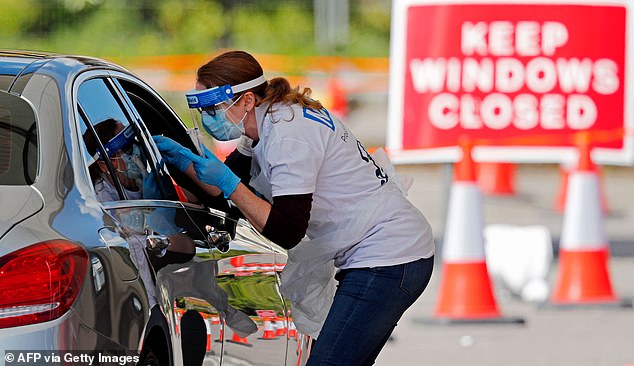Matt Hancock confirms coronavirus test rationing will see hospital patients, care home residents and NHS staff get swabs before the general public
- Officials say demand for tests is outstripping supply by up to four times
- Strain on the system has led to long delays to results and unavailability for some
- Department of Health says members of the public are last in line to get tests
- Teachers who feel ill will get priority over public to enable schools to stay open
Hospital patients, care home residents and NHS staff will be at the front of the queue for coronavirus tests, the Department of Health confirmed today.
As demand for swab tests is now outstripping supply – by up to four times as much, according to Test & Trace chief Dido Harding – health chiefs have confirmed their priorities.
Bottom of the list are members of the public who think they have the virus, while those living in areas known to have high infection rates will be higher up the list.
People across England have complained of tests being unavailable anywhere near their homes and being instructed to travel hundreds of miles to an available centre.
The limited numbers of tests available – currently around 257,000 per day, according to officials – have had to be targeted at areas with worse outbreaks, leaving people living in less-affected areas struggling to get access.
Now, Health Secretary Matt Hancock and his department have confirmed how tests are being rationed across the UK.
Care homes are known to have around 100,000 made available to them each day, because their residents are the most likely to die if they catch the virus.
And NHS hospitals must be able to test all patients while they are in hospital or being newly admitted.
Officials in the UK have admitted that demand for coronavirus swab tests is higher than supply and have now set out a priority list outlining how they will be rationed
In a priority list published today the Department of Health said: ‘While capacity is at a record high, demand has rapidly increased and is currently above these levels.
‘As we look towards winter, we have set out below those who we intend to test, as well as how and why we will test them.
‘The exact allocation of tests across these key areas is dynamic and may change, as it is based on the latest evidence on risk and demand.’
In ranking order these are how tests will be prioritised:
- NHS hospital patients, including all new inpatient admissions
- Care home staff (weekly) and residents (monthly and on admission)
- NHS staff
- Surveillance studies to collect data, and targeted testing at high-risk environments
- Teachers who have symptoms
- Members of the public with symptoms in areas with high infection rates
- Members of the public with symptoms in other areas
Mr Hancock said: ‘The testing capacity we have is valuable. And we must together prioritise it for the people who need it the most.’
Testing will also be targeted in outbreak areas and teachers will also be given priority.
Among the wider public, people in areas with high incidence will be given priority.
Speaking in the House of Commons, Mr Hancock said testing capacity was at a record high 253,521 but ‘alongside this record expansion, demand has gone up too’.
He told MPs: ‘We need to prioritise the tests on those who need the most to save lives, protect the most vulnerable and make sure our health and care services and our schools can operate safely.
‘Today we’ve published our list of where tests are being prioritised, setting out how we will make sure tests are allocated where they’re needed most.
‘First, to support acute clinical care. Second, to support and protect people in care homes. Third, NHS staff including GPs and pharmacists. Fourth, targeted testing for outbreak management and surveillance studies. Fifth, testing for teaching staff with symptoms, so we can keep schools and classes open.
‘And then the general public when they have symptoms, prioritising those in areas of high incidence.’
